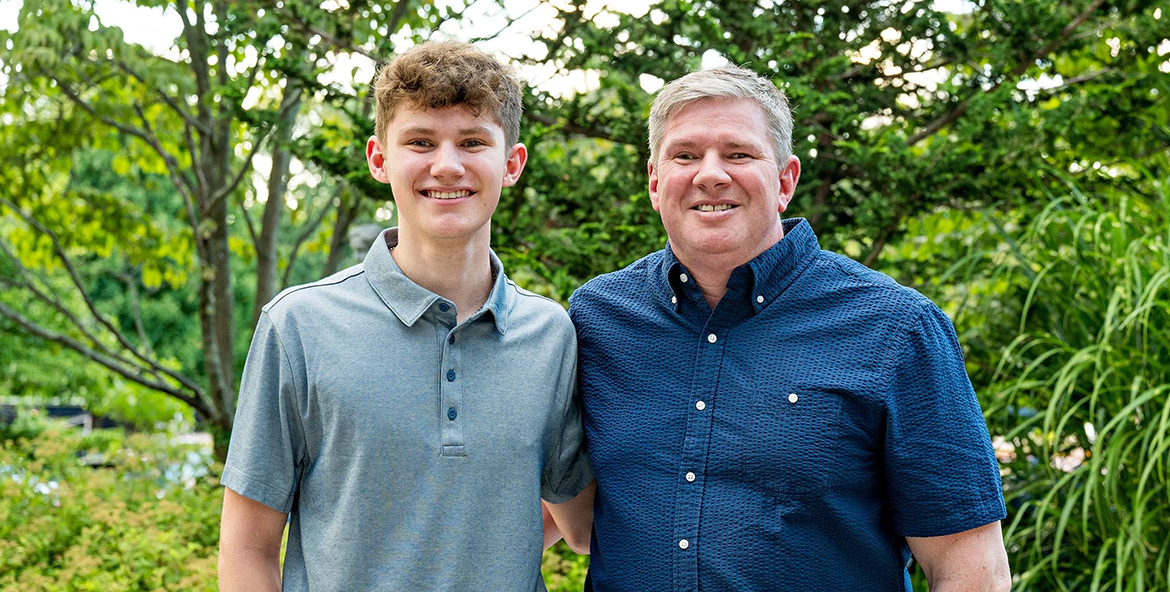Solving Medicine’s Most Elusive Mysteries
The Undiagnosed Diseases Network identifies the rarest of diseases and discovers new ones
The Undiagnosed Diseases Network identifies the rarest of diseases and discovers new ones

Over the course of 12 years, Brendon Paradis lost his eyesight to a disease with no name. Starting in his mid-20s, his symptoms puzzled one doctor after another, leaving him bouncing between specialists as his vision faded. By age 37, he was completely blind, and no one knew why.
The answer finally came in 2019, when his young son, Keegan, received a diagnosis: ROSAH syndrome. Fewer than 70 people worldwide have been diagnosed with this inherited autoimmune disorder, which inflames the optic nerve, joints, and spleen. Left untreated, it causes retinal damage and vision loss, as it did with Brendon. He hopes Keegan’s future will be different.
Keegan was in first grade when a routine exam detected mild eye inflammation. Multiple specialists later, he was referred to the Undiagnosed Diseases Network (UDN), a National Institutes of Health-funded program on a mission to solve the rarest and most confounding of medical cases, illuminate the processes that fuel these diseases, and generate broader insights about human health.
With Keegan’s diagnosis, the pieces of the puzzle finally fell into place, Brendon says. It explained why Brendon's own father’s vision loss was attributed to retinitis pigmentosa, a genetic condition Brendon did not have.
“Keegan’s diagnosis led to Brendon getting diagnosed and other family members getting tested and diagnosed, and it’s altered the trajectory of the treatment,” says Keegan’s mother, Andria Paradis. “Keegan is getting treated in the hopes of keeping inflammation at bay to avoid the same outcome as Brendon.”
Stories like Brendon’s are common among those with rare diseases. Patients often spend years searching for answers, frustrated and scared, as their diseases progress relentlessly. But since the UDN’s inception in 2014, researchers have discovered nearly 100 new conditions, and diagnosed 855 individuals with previously unknown diseases. The progress made by the UDN — and the broader field of rare disease research — could also bring about insights into more common conditions and benefit the field of medicine more broadly.
Although each rare disease occurs in a relatively small number of people — fewer than 200,000 per condition in the U.S. — collectively, they affect an estimated 25 million people in this country and 300 million globally. Of the 10,000 known rare diseases, 95 percent have no treatment. Identifying the cause of a condition — the exact molecular glitch that ignites it — is key to developing treatments that go beyond symptom relief and target the disease at its very root. This is the UDN’s reason for being.
The work takes place across 24 clinical sites nationwide. HMS helms the UDN’s research activities and leads its data operations. Under principal investigator Zak Kohane, head of the department of biomedical informatics in the Blavatnik Institute, HMS oversees the collection, management, and storage of research data emanating from participating hospitals. HMS also leads activities such as AI tool development, genomic analysis, and outreach and engagement at UDN centers across the U.S.: Morehouse School of Medicine, University of Alabama at Birmingham, University of Utah, Washington University in St. Louis, and Stanford University.
The UDN embodies the principles of precision medicine, tailoring diagnoses and treatments to individual patients based on their unique genetic and molecular profiles. This model could serve as a blueprint for improving standard medical care as a whole.
“When conventional medicine does not have the answer, deeper and focused research turns into action to diagnose many of these patients for the first time in years and start them on treatments,” says Kohane. “This demonstrates how research and clinical care can be productively linked.”
The UDN’s approach streamlines complex medical evaluations, compressing them into several days of intensive testing with a multidisciplinary team. Data and biological samples collected from patients are stored and shared, enabling future research and collaboration. Unlike standard medical practice, which often lacks a direct link between clinicians and researchers, the UDN fosters continuous interaction between the two, enhancing both diagnosis and treatment strategies.
“We see these types of collaborations in rare disease research, but in mainstream medicine, they’re far less common,” says Kim LeBlanc, senior director of the UDN Coordinating Center at HMS. “By working closely together, clinicians and researchers gain deeper insights that improve both patient care and scientific discovery.”
Read full article in Harvard Medicine Magazine
Also see
What’s in that $9 billion the Trump administration is reviewing at Harvard? | The Boston Globe
© 2025 by the President and Fellows of Harvard College